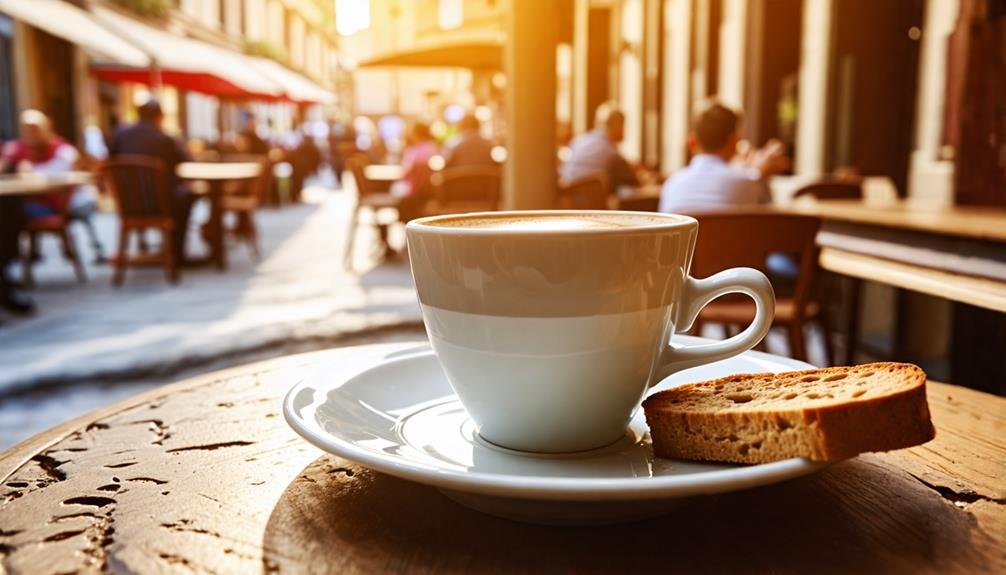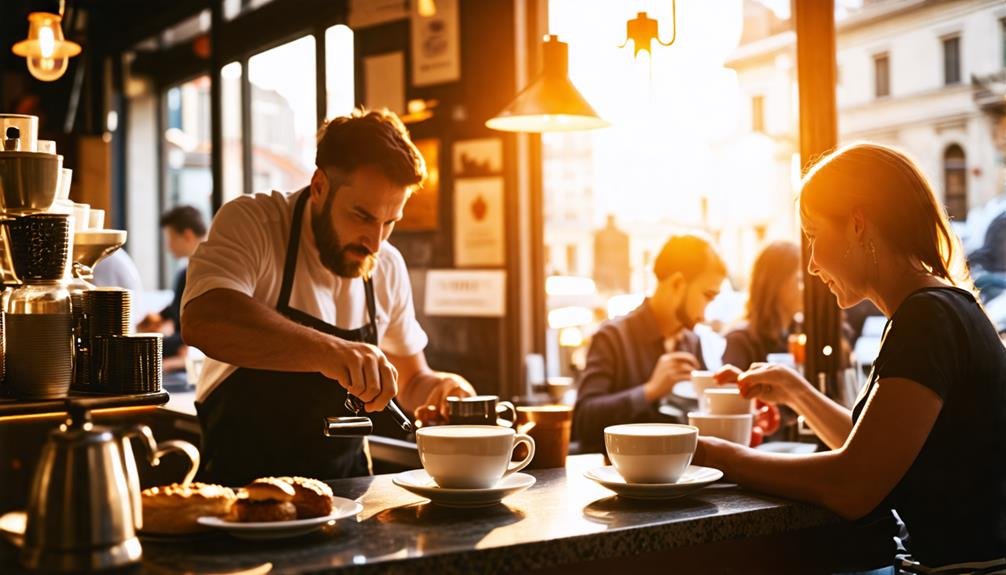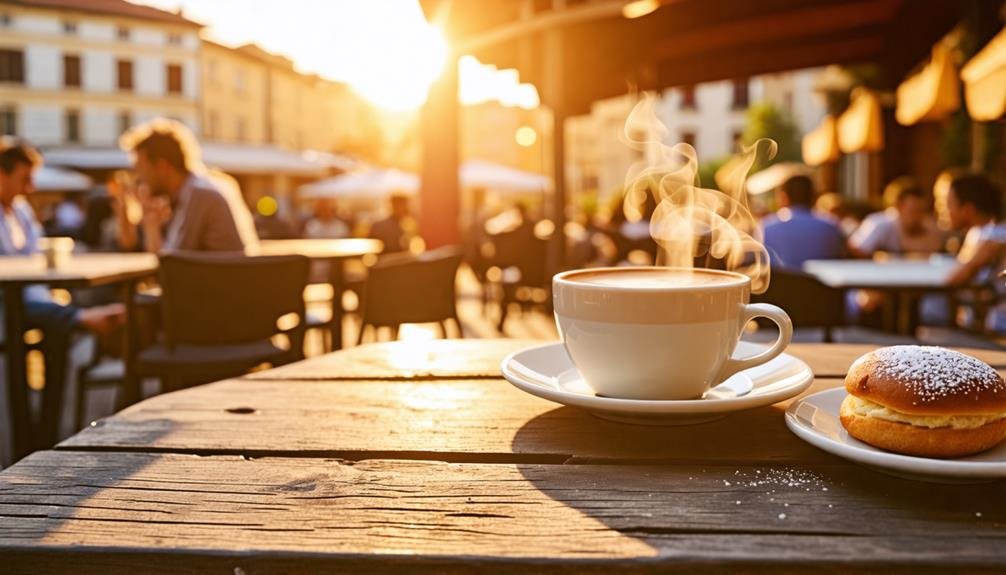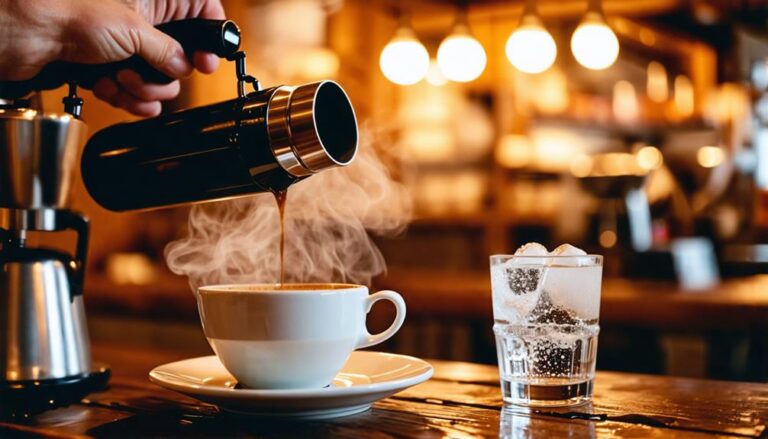In Italy, cappuccino is exclusively a morning beverage, typically consumed before 11 a.m. This reflects the cultural practice where heavier milk-based drinks are not favored in the afternoon. Italians prefer lighter options like espresso, or caffè macchiato, which aligns with their coffee traditions. In the afternoon, alternatives such as caffè freddo and caffè corretto are popular, often served with a small glass of water to cleanse the palate. Understanding these customs enriches the Italian coffee experience and shows respect for local traditions. Continuing on this topic can provide further insight into Italy's rich coffee culture and its unique variations.
The Tradition of Cappuccino
Cappuccino, an iconic Italian morning drink, represents a cherished custom embedded in the nation's espresso culture. The crafting of a cappuccino in Italy is an exquisite process, marked by the ideal combination of espresso, frothed milk, and creamy foam. This drink is typically consumed during breakfast, reflecting Italian traditions that stress the importance of beginning the day with a satisfying ritual.
Regarding coffee customs, Italians follow particular guidelines for enjoying cappuccino. It is standard practice to order this beverage before 11 a.m.; having a cappuccino later may attract disapproving looks and be seen as a tourist mistake. This strict timing illustrates a deeper appreciation for coffee's role in everyday life, where beverages are not just enjoyed but are woven into social practices.
Furthermore, the cappuccino experience transcends the drink itself; it encourages patrons to relish their surroundings and the moment. Thus, the cappuccino remains a beloved emblem of Italian coffee culture, embodying a seamless blend of tradition and social norms.
Morning Coffee Ordering Tips
When ordering coffee in Italy, timing and terminology are crucial for a seamless experience. It is advisable to order your cappuccino before 11 a.m. to align with local customs, and familiarizing yourself with key phrases such as 'Vorrei un …' can improve communication. Also, be cautious when requesting milk, as ordering a latte could lead to receiving a glass of plain milk instead of the expected beverage.
Order Before 11 A.M
To truly immerse yourself in Italian coffee culture, order a cappuccino before 11 a.m. This practice aligns with local customs and helps you avoid being perceived as a tourist. Italians typically enjoy cappuccino during breakfast hours, making it an integral part of their morning routine. Following this tradition shows your respect for local etiquette, enriching your experience in Italian society.
When you order your cappuccino, try standing at the bar for a more authentic encounter. This enables direct interaction with the barista and allows you to savor your drink in a vibrant atmosphere. It's wise to limit your intake of milk-based beverages throughout the day, as this can further mark you as a tourist.
If you're interested in alternatives like decaffeinated options, simply ask for a 'decaffeinato.' Be cautious with the term 'latte,' as it may lead to a glass of milk instead of the coffee drink you anticipate. The essence of enjoying coffee in Italy lies in honoring local customs and embracing the cultural subtleties that surround this beloved ritual. Thus, ordering your cappuccino before 11 a.m. is not merely a suggestion; it invites you to partake in Italy's rich coffee legacy.
Essential Italian Phrases
Mastering essential Italian phrases is crucial for confidently ordering your morning espresso and enhancing your overall experience in Italy. Start with 'Vorrei un …' (I would like a …), which helps you express your coffee choice with assurance. When ordering a cappuccino, be sure to say 'un cappuccino, per favore' to maintain polite interaction. If you desire a decaffeinated option, simply ask for 'un decaffeinato' or 'un deca.'
Italians typically don't use the terms small, medium, or large; thus, knowing the standard sizes is important. For a double shot of espresso, request 'un espresso doppio.' If you're interested in alternative milk varieties, learn to say 'latte di mandorla' for almond milk, 'latte di cocco' for coconut milk, and 'latte di soia' for soy milk.
Grasping these phrases not only streamlines your transactions but also deepens your cultural experience. Communicating effectively demonstrates respect for Italian traditions, assisting you in blending into the local coffee scene. By embracing this knowledge, you can fully enjoy your morning routine in Italy, relishing both the coffee and the experience.
Avoiding Milk Confusion
Ordering espresso in Italy can be challenging, especially with the various dairy options available. To navigate this situation, it's essential to understand local customs regarding dairy in espresso. For example, if you desire a cappuccino, ensure you order it before 11 a.m. to fit Italian breakfast traditions. Additionally, avoid asking for a latte, as this will likely result in being served a glass of milk instead of the anticipated coffee beverage. Instead, if you prefer a creamy choice, consider requesting a caffè macchiato, which consists of an espresso 'stained' with a small amount of steamed milk.
Many cafés in Italy now provide alternative dairy options, such as almond, coconut, and soy milk, enhancing your coffee experience. To ensure a seamless ordering process, familiarize yourself with essential phrases like 'Vorrei un…' (I would like…) and 'per favore' (please), and don't hesitate to specify your preferences. By mastering these details, you can confidently savor your morning espresso without the worry of dairy confusion, embracing the opportunity to explore Italy's rich coffee culture.
Afternoon Coffee Choices

In the afternoon, Italian coffee lovers often select from a range of espresso-based drinks that suit various tastes and occasions. One popular option is an espresso shot, or un caffè, which delivers a robust flavor, ideal for a midday pick-me-up. For those seeking a gentler choice, a caffè Americano, created by adding hot water to espresso, serves as a perfect substitute.
The caffè macchiato, which includes a touch of frothy steamed milk, strikes a delightful balance between the boldness of espresso and the smoothness of milk. In warmer months, an invigorating caffè freddo—espresso blended with ice and sugar—becomes a favored refreshment. For the more adventurous, a caffè corretto, where a hint of alcohol like grappa or sambuca enhances the espresso, offers a unique twist.
It is customary to receive a small glass of water alongside your espresso to cleanse the palate. These afternoon coffee selections showcase the Italian dedication to quality and tradition, enabling individuals to explore diverse flavors while enjoying their coffee breaks with elegance and flair.
Understanding Italian Coffee Culture
Understanding Italian coffee culture is crucial for anyone looking to enjoy an authentic experience. The timing of ordering a cappuccino is critical, as it is strictly a breakfast beverage, while espresso variations like caffè macchiato and caffè corretto offer fascinating options for different times of the day. By grasping these nuances, one can navigate the Italian coffee landscape with confidence and appreciation.
Cappuccino Timing Importance
The timing of savoring a cappuccino in Italy is essential. This creamy beverage is traditionally reserved for the morning hours, reflecting the unique Italian coffee culture. Italians typically enjoy cappuccinos shortly after breakfast, often before 11 a.m. This custom is rooted in the belief that milk-based drinks can disrupt digestion if consumed later in the day. By following this tradition, one aligns with local practices, avoiding the perception of being a tourist.
In Italy, coffee consumption is a cherished ritual woven into social interactions. Ordering a cappuccino at a café like Lavazza after the designated morning hours may elicit disapproving looks or remarks from baristas and locals. Instead, visitors are encouraged to explore alternatives such as a classic espresso or a caffè macchiato during the afternoon.
Recognizing the importance of cappuccino timing enhances one's appreciation for Italian coffee culture and fosters a deeper connection with the local lifestyle. Embracing these traditions allows for a more authentic experience, where one can relish the rich flavors of Italy while honoring its time-honored customs.
Espresso Variations Explained
Italy's coffee culture showcases a variety of espresso types, each offering unique flavors and preparation techniques. The quintessential espresso forms the base for numerous delightful variations. For example, a caffè macchiato consists of a shot of espresso topped with a dollop of frothy steamed milk, creating a harmonious blend of robust taste and creaminess.
As the temperature rises, caffè freddo gains popularity, featuring chilled espresso served over ice with sugar, making for a refreshing beverage. For those desiring a bolder experience, the caffè corretto adds an exciting twist by incorporating a splash of spirits like grappa or sambuca.
Typically, each variation is served with a small glass of water to cleanse the palate, enhancing the tasting journey. Familiarity with these espresso types deepens one's appreciation for Italian coffee culture, encouraging enthusiasts to explore beyond standard choices. Embracing the intricacies of these beverages enriches the coffee experience and resonates with the Italian tradition of savoring every moment.
Common Misunderstandings About Coffee

Many tourists visiting Italy hold misconceptions about coffee habits, often resulting in uncomfortable moments in local cafés. A frequent misunderstanding is the idea that cappuccinos are acceptable at any hour. In truth, this creamy beverage is mainly regarded as a morning drink, and locals may find it unusual to order one after 11 a.m. Additionally, visitors often request sizes like small, medium, or large, while Italian coffee culture sticks to standard measurements, serving drinks in petite cups.
Another common error is believing that ordering a latte will produce a flavorful coffee drink. Instead, it typically results in a cup of plain milk, as lattes are not commonly recognized in Italy's coffee offerings. Furthermore, while sampling coffee varieties, travelers might miss out on Italian specialties such as caffè macchiato and caffè corretto, both of which provide distinct tastes and experiences.
Communication Tips for Ordering
To navigate the Italian coffee scene effectively, clear communication is key. Use the phrase 'Vorrei un …' (I would like a …) followed by your drink of choice for politeness and clarity, adding 'per favore' (please) to enhance your request.
When ordering decaffeinated options, mention 'decaffeinato' or 'deca.' Remember, if you ask for 'latte,' you might receive milk instead of a coffee drink, so opt for 'caffè latte' to avoid misunderstandings. Familiarizing yourself with non-dairy alternatives like almond, coconut, and soy milk can also be beneficial.
In Italy, coffee sizes are standardized, so there's no need for terms like small, medium, or large; simply specify your drink type. For a stronger experience, ask for an 'espresso doppio' for a double shot of espresso.
Unique Italian Coffee Experiences

Italian coffee culture presents a plethora of unique experiences that transcend standard offerings, inviting aficionados to explore diverse flavors and brewing methods. In Italy, coffee transcends mere consumption; it embodies a rich tradition, with each region showcasing its own specialties. Engaging with these distinct beverages can unveil exciting discoveries in taste and preparation.
Consider indulging in these exceptional options:
- Caffè Corretto: An espresso enhanced with a dash of grappa or sambuca, delivering a robust and warming sensation.
- Caffè Freddo: Ideal for the summer heat, this beverage features chilled espresso sweetened with sugar and served over ice for a refreshing treat.
- Caffè Macchiato: A classic espresso “stained” with a touch of frothed milk, perfect for those desiring a creamy experience without overwhelming richness.




